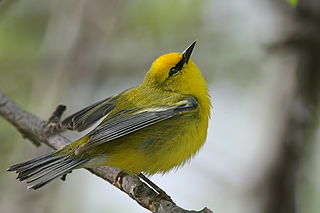 W
WThe New World warblers or wood-warblers are a group of small, often colorful, passerine birds that make up the family Parulidae and are restricted to the New World. They are not closely related to Old World warblers or Australian warblers. Most are arboreal, but some, like the ovenbird and the two waterthrushes, are primarily terrestrial. Most members of this family are insectivores.
 W
WBasileuterus is a genus of New World warblers, best represented in Central and South America. This is one of only two warbler genera that are well represented in the latter continent. Some species formerly considered in this genus are now placed in the genus Myiothlypis. It is likely that the ancestors of this genus colonised South America from the family's heartland in northern Central America even before the two continents were linked, and subsequent speciation provided most of the resident warbler species of that region.
 W
WThe black-and-white warbler is a species of New World warbler, and the only member of its genus, Mniotilta. It breeds in northern and eastern North America and winters in Florida, Central America, and the West Indies down to Peru. This species is a very rare vagrant to western Europe.
 W
WErgaticus was a genus of New World warblers — small passerine birds found only in the Americas. It was subsumed into Cardellina in 2011. The name is the Latinized version of the Ancient Greek ergatikos, meaning "willing or able to work". The genus contains two sister species: the red warbler, which is endemic to the Mexican highlands north of the Isthmus of Tehuantepec, and the pink-headed warbler, which is found south of the Isthmus, from the highlands of Chiapas, Mexico down into Guatemala. Though they are separated by geography and differ considerably in plumage, the two have sometimes been considered to be conspecific.
 W
WParula was formerly a small genus of New World warblers which breed in North and South America.
 W
WThe prothonotary warbler is a small songbird of the New World warbler family. It is the only member of the genus Protonotaria.
 W
WSemper's warbler is an extremely rare or possibly extinct New World warbler which is endemic to Saint Lucia, part of the Lesser Antilles.
 W
WSwainson's warbler is a small species of New World warbler. It is monotypic, the only member of the genus Limnothlypis. Swainson's warbler was named after William Swainson, an English ornithologist.
 W
WVermivora is a genus of New World warblers.
 W
WThe whistling warbler is a species of bird in the New World warbler family. It is monotypic within the genus Catharopeza. It has a dark back that fades into a lighter gradient going towards the chest. It also has a dark head, a dark strip on the breast, and a light orbital. Both male and female have the same plumage. It is endemic to the island of Saint Vincent in the Lesser Antilles. Its natural habitats are subtropical or tropical moist lowland forest and subtropical or tropical moist montane forest. It is threatened by habitat loss. This habitat loss is due to volcanic activity and deforestation. Whistling warblers have cup-shaped nests, and spotted eggs. Their diet primarily consists of insects.
 W
WWilsonia is a small genus of New World warblers which breed in North America. They are migratory, wintering south of their breeding ranges in Central America, the West Indies or South America.
 W
WThe worm-eating warbler is a small New World warbler that breeds in the Eastern United States and migrates to southern Mexico, the Caribbean, and Central America for the winter.